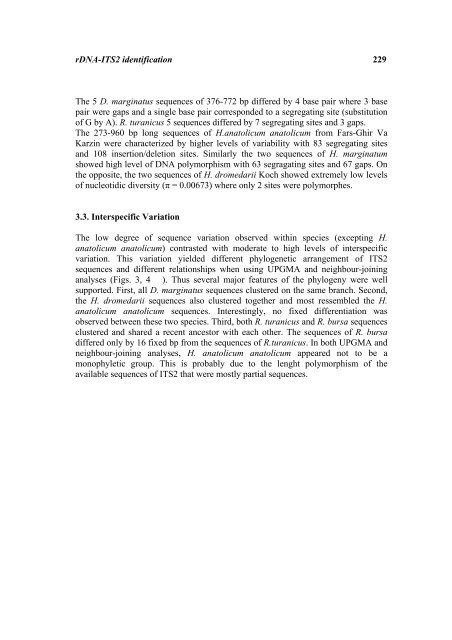rDNA-ITS2 Identification of Hyalomma, Rhipicephalus ... - HIKARI Ltd
rDNA-ITS2 Identification of Hyalomma, Rhipicephalus ... - HIKARI Ltd
rDNA-ITS2 Identification of Hyalomma, Rhipicephalus ... - HIKARI Ltd
Create successful ePaper yourself
Turn your PDF publications into a flip-book with our unique Google optimized e-Paper software.
DNA-<strong>ITS2</strong> identification 229<br />
The 5 D. marginatus sequences <strong>of</strong> 376-772 bp differed by 4 base pair where 3 base<br />
pair were gaps and a single base pair corresponded to a segregating site (substitution<br />
<strong>of</strong> G by A). R. turanicus 5 sequences differed by 7 segregating sites and 3 gaps.<br />
The 273-960 bp long sequences <strong>of</strong> H.anatolicum anatolicum from Fars-Ghir Va<br />
Karzin were characterized by higher levels <strong>of</strong> variability with 83 segregating sites<br />
and 108 insertion/deletion sites. Similarly the two sequences <strong>of</strong> H. marginatum<br />
showed high level <strong>of</strong> DNA polymorphism with 63 segragating sites and 67 gaps. On<br />
the opposite, the two sequences <strong>of</strong> H. dromedarii Koch showed extremely low levels<br />
<strong>of</strong> nucleotidic diversity (π = 0.00673) where only 2 sites were polymorphes.<br />
3.3. Interspecific Variation<br />
The low degree <strong>of</strong> sequence variation observed within species (excepting H.<br />
anatolicum anatolicum) contrasted with moderate to high levels <strong>of</strong> interspecific<br />
variation. This variation yielded different phylogenetic arrangement <strong>of</strong> <strong>ITS2</strong><br />
sequences and different relationships when using UPGMA and neighbour-joining<br />
analyses (Figs. 3, 4 ). Thus several major features <strong>of</strong> the phylogeny were well<br />
supported. First, all D. marginatus sequences clustered on the same branch. Second,<br />
the H. dromedarii sequences also clustered together and most ressembled the H.<br />
anatolicum anatolicum sequences. Interestingly, no fixed differentiation was<br />
observed between these two species. Third, both R. turanicus and R. bursa sequences<br />
clustered and shared a recent ancestor with each other. The sequences <strong>of</strong> R. bursa<br />
differed only by 16 fixed bp from the sequences <strong>of</strong> R.turanicus. In both UPGMA and<br />
neighbour-joining analyses, H. anatolicum anatolicum appeared not to be a<br />
monophyletic group. This is probably due to the lenght polymorphism <strong>of</strong> the<br />
available sequences <strong>of</strong> <strong>ITS2</strong> that were mostly partial sequences.
















